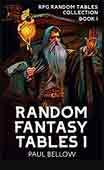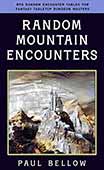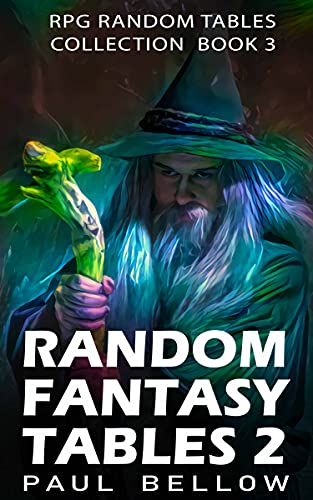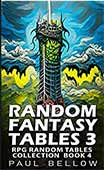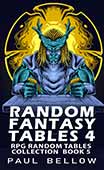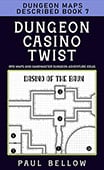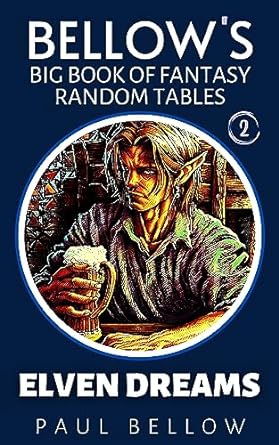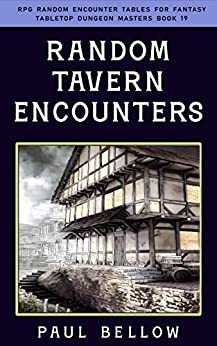In the fast-paced world of gaming, where trends shift quicker than a speedrunner skips cutscenes, a new debate has dropped—and it’s got everyone talking. The rise of AI-generated D&D art is stirring things up in a big way.
For years, tech has been a core part of game dev. From physics engines to facial animations, we’ve always relied on innovation. But now AI is stepping into the creative zone, and that’s where it gets spicy.
On one side: you’ve got the folks who see AI art as the next big thing. It’s fast, it’s flexible, and it can crank out character portraits or fantasy landscapes in seconds. For indie devs or small teams, it’s a game-changer—literally.
On the other: artists and fans who’ve been crafting this world by hand for years. They see creativity as something deeply human. AI might be cool, but can it capture the soul of a game world? The personality in a player character’s face? The grit in a dungeon map inked at 2AM?
This isn’t just about tech. It’s a conversation about ownership, creativity, and what makes art real in gaming culture. Who gets credit? What does it mean to “create” something? And how do we value the time and skill of human artists in a world where machines can mimic style?
The lines are being drawn, and the discussion’s only heating up. Whether you’re team AI, team hand-drawn, or somewhere in the middle, one thing’s for sure—this debate is changing how we look at game art, and maybe how we define creativity itself.
The Controversy Unleashed: AI in Official Game Art

A storm was unleashed in the gaming community when it was revealed that AI-generated elements had wormed their way into official Dungeons & Dragons art. A celebrated game known for its richly immersive fantasy worlds and hand-crafted artistry suddenly found itself at the center of a heated debate. What began as a typical release quickly transformed into a flashpoint for larger conversations about the role AI should play in creative industries—a topic fraught with tension and conflicting viewpoints.
The inciting incident involved an artist’s covert use of AI tools while crafting official game art for Dungeons & Dragons, one of the most venerated names in tabletop RPGs. Fans, who cherished the human touch that brought their favorite realms to life, felt betrayed. The incident spotlighted the growing unease within the community about AI’s encroachment on creative processes traditionally driven by human imagination.
Try my AI Tabletop RPG generators...and an extensive library of content!
The publisher’s response to this uproar was immediate, yet underscored the complex landscape of corporate responsibility in a rapidly changing technological environment. While the use of AI was not explicitly forbidden, it exposed a gap in existing policies and raised questions about artistic integrity and transparency. As the community grappled with these revelations, broader discussions emerged about the role of AI in gaming art—an area with little to no precedent, where regulations and ethical guidelines are still in their infancy.
This incident served as a lightning rod for the frustrations and fears that many creators and fans harbor about AI’s potential to devalue human artistry. It opened up a Pandora’s box of issues, ranging from accusations of deception and breach of trust to debates over the future of artistic creation in the digital age. What has become clear is that the lines between human and machine-generated art are increasingly blurred, demanding a reevaluation of what constitutes originality and creative ownership.
⚔️ Fantasy RPG Random Tables Books
Make life as a Gamemaster easier…
If you play Dungeons & Dragons, Pathfinder, or other fantasy RPGs, this
RPG random tables series
is packed with encounters, NPCs, treasure, and more. Available in eBook or print—either way, you’ll have a wealth of adventure ideas at your fingertips.
What Happened in the D&D Incident?
The D&D AI-art debacle began quietly, as most tempestuous events do. The art piece in question was released without fanfare, integrated into the highly anticipated series of official content for Dungeons & Dragons. Initially met with the usual enthusiasm, it wasn’t long before eagle-eyed fans noticed something amiss. A discussion emerged regarding the artwork’s unusual style and composition, leading to speculation about the tools used in its creation.
The artist later admitted to incorporating AI-generated elements within the piece, setting off a chain reaction within the community. Fans and creators alike voiced their concerns, some expressing feelings of betrayal while others defended the artist’s choice as a modern adaptation of art practices. The revelation sparked a broader discourse about what constitutes fair use of technology in art, and whether AI should have a place in traditionally hand-crafted domains like D&D.
As fans dug deeper, they discovered omens of a larger trend—a creeping reliance on AI in creative work that could potentially replace human artists altogether. This revelation prompted immediate backlash. Artists who had honed their skills over years of practice found themselves overshadowed by a technology that churned out art at breakneck speeds. Calls for change began to echo through the community, demanding clarity and stricter guidelines to preserve the integrity of creative work.
- Accusations of artistic deception sparked by AI use.
- Community calls for policy changes on art creation.
- Some fans defended the inclusion of technology in art.
- Boycotts of the product line containing AI elements.
- Petitions circulated demanding transparency in art sourcing.
- Concerns raised over the potential job loss for human artists.
- Debates on social media platforms about artistic integrity.
- Discussions initiated about broader implications for the industry.
- Artists voiced fears about creative devaluation.
- Some creators advocated for AI as a tool rather than a replacement.
- Publishers faced pressure to reassess art commissioning processes.
- A split in the fanbase emerged over support for AI inclusion.
As the dust began to settle, it was evident that the incident had left an indelible mark on the gaming community. It highlighted the urgent need for a transparent dialogue about the future of AI in artistic endeavors and underscored the tensions that accompany technological advancement. For some, AI’s place in art remains anathema, while others see it as an inevitable part of the creative evolution.
To conclude, the D&D controversy serves as a microcosm of the larger debate surrounding AI in creative industries. As tensions simmer, it’s clear that this is just the beginning of a profound conversation about the place of technology in art. The incident has set the stage for an ongoing discourse that will shape how art is created, perceived, and valued in the digital age, challenging communities to reimagine the boundaries between tradition and technology.
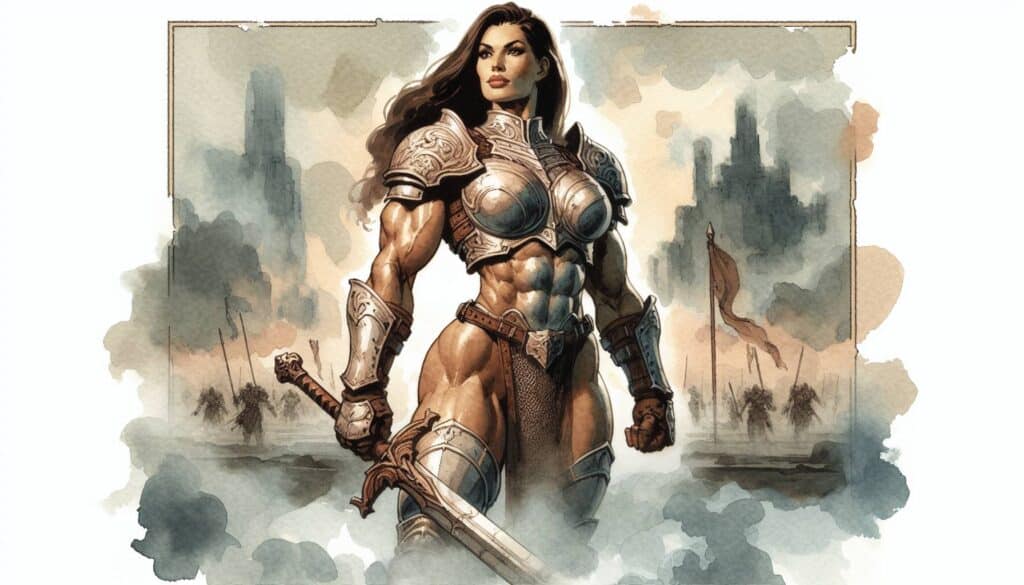
Ethics of AI in Creative Work
The integration of AI into creative processes raises intricate ethical considerations, forcing stakeholders to navigate a labyrinth of moral dilemmas. Chief among these is the issue of consent and copyright. In a world where AI can replicate artistic styles and mimic human creations, questions arise about who truly owns the resulting work. The lines between original and generated work become increasingly blurred, leaving artists, publishers, and fans grappling with the implications.
For artists, the primary concern lies in maintaining control over their creative output. The use of AI can feel like an encroachment on their intellectual property, reducing years of dedication and craftsmanship to algorithms that generate art with a few clicks. This fear is compounded by the risk of unauthorized replication of their artistic styles, raising alarms about the potential for plagiarism and loss of credit.
Publishers, on the other hand, face the challenge of balancing efficiency with ethical responsibility. While AI offers the allure of speed and cost savings, it threatens to undermine the authenticity that fans associate with handcrafted art. The risk of alienating dedicated fanbases looms large, prompting calls for clearer guidelines and ethical standards when incorporating AI into creative workflows.
Fans, deeply invested in the cultural and emotional resonance of gaming art, worry about the commodification of creativity. AI-generated works, they argue, may lack the soul and intentionality of human-created art, leading to a sterile, homogenized artistic landscape. The emotional connection that fans experience with their favorite games and worlds could be diminished, potentially eroding the community’s cultural fabric.
AI companies, too, play a pivotal role in this ethical quagmire. By promoting the capabilities of their tools without addressing the potential consequences, they contribute to the growing concern about AI’s impact on creative industries. A collaborative effort is needed to establish guidelines that honor both technological progress and the sanctity of artistic expression.
| Ethical Concerns | Stakeholder Perspectives | Real-World Examples | Proposed Solutions |
|---|---|---|---|
| Consent and Copyright | Artists worry about IP infringement | AI replicating known styles without consent | Implementing consent management tools |
| Loss of Artistic Control | Publishers balance efficiency vs. ethics | AI-generated art used without artist approval | Licenses that protect artist contributions |
| Authenticity and Integrity | Fans seek genuine human connection | AI art lacking emotional depth | Transparency labels for AI-involved works |
| Job Displacement | AI companies push efficiency narratives | Human artists replaced by AI-generated content | Encouraging hybrid workflows with human artists |
| Plagiarism Risks | Ethical standards for AI companies | Replication of unique styles by AI models | Licensing AI outputs under artist supervision |
| Devaluation of Art | Emotional investment vs. cost-cutting | Over-reliance on algorithms in creative processes | Educational initiatives on AI ethics |
| Commodification of Creativity | Fans’ cultural investment threatened | AI art becoming the norm due to lower costs | Incentivizing artist involvement in technology |
| Bias in AI Outputs | Artists lose distinct voice recognition | Algorithmic biases in art generation | Diverse training datasets for AI tools |
| Transparency in Usage | Publishers pressured for clarity | Undisclosed AI elements in marketed products | Mandating disclosure of AI components |
| Legal Liability | Collaboration challenges in shared IP | Disputes over co-created works with AI | Clear contract terms for AI-art collaborations |
Navigating these ethical waters will require cooperation across the board—from artists and publishers to AI companies and fans. By fostering open discussions around consent, ownership, and the cultural significance of art, the industry can establish ethical guidelines that honor both innovation and tradition.
⚔️ Fantasy RPG Random Tables Books
Make life as a Gamemaster easier…
If you play Dungeons & Dragons, Pathfinder, or other fantasy RPGs, this
RPG random tables series
is packed with encounters, NPCs, treasure, and more. Available in eBook or print—either way, you’ll have a wealth of adventure ideas at your fingertips.
In summary, the ethical implications of AI in creative work underscore the need for a careful balance between technological advancement and the preservation of artistic integrity. As the debate continues, it’s crucial to ensure that innovation complements, rather than compromises, the rich tapestry of human creativity. Through collaboration and thoughtful consideration, the gaming industry can chart a path forward that embraces both art and algorithm.
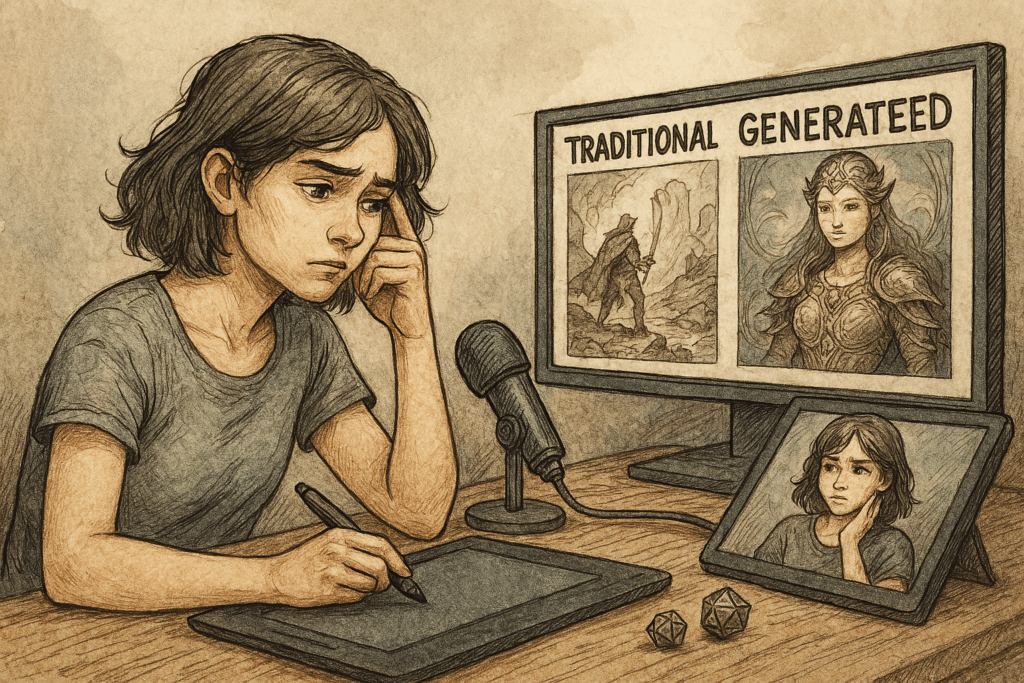
The Human Touch: What’s at Stake?
In the realm of gaming, where fantasy and adventure come alive through the intricate interplay of narrative and visual artistry, the human touch holds profound significance. It is this very essence that AI-generated art threatens to erode, calling into question the cultural and emotional value of hand-crafted art. For fans and creators alike, the artistry in games is more than pixels and polygons; it’s an expression of individuality, identity, and intention.
The emotional depth that human artists bring to their work cannot be overstated. Each brushstroke is infused with intention, reflecting the artist’s unique vision and perspective. This intentionality resonates with players, allowing them to connect with characters and worlds on a deeply personal level. For many, the visual narrative is as integral to the gaming experience as the gameplay itself.
Moreover, human-made art embodies a unique style that AI struggles to replicate. Each artist brings their own flair, resulting in visuals that are as diverse and varied as the artists themselves. This diversity is a celebration of cultural identity, offering players a window into the rich tapestry of human creativity. In a world where gaming is a global phenomenon, this cultural exchange enhances the universality of the gaming experience.
Intentional imperfection is another aspect that endears human-made art to its audience. The quirks and subtleties in hand-crafted visuals lend authenticity and charm, rendering each piece one-of-a-kind. These imperfections create a sense of intimacy, inviting players to revel in the beauty of artistry that transcends the purely functional.
- Emotional depth and resonance with audiences.
- Unique artistic styles that reflect individual creativity.
- Cultural identity and heritage in visual storytelling.
- Intentional imperfections that add character and charm.
- A personal connection between artist and audience.
- Dynamic expression of human emotions and experiences.
- Visual storytelling that enhances narrative depth.
- The infusion of personal and historical contexts.
- Symbolic motifs and allegorical elements in art.
- Artistic risks and experimentation that push boundaries.
- Collaborative spirit in artistic endeavors.
- The evolution of art reflecting societal changes.
- Preservation of traditional art techniques.
- A platform for marginalized voices and perspectives.
- Art as a vehicle for personal and political expression.
In a gaming landscape increasingly influenced by technology, preserving the human touch in artistry is paramount. It ensures that games remain not just sources of entertainment but also conduits for cultural expression and emotional connection. As AI continues to evolve, the challenge lies in integrating it in ways that augment, rather than replace, the invaluable contributions of human artists.
To close, the stakes in maintaining the human touch in game art extend beyond aesthetics. They encompass the very heart of what makes gaming an enriching, illuminating experience. By valuing and safeguarding the contributions of human artists, the industry can continue to foster creativity that inspires players and unites communities, bridging cultures and generations through the universal language of art.
Game Studios and AI: Navigating the New Normal
The dawn of AI in art creation has prompted game developers, publishers, and freelance artists to confront an evolving landscape. This technological revolution offers both opportunities and dilemmas, prompting a reevaluation of processes, expectations, and ethical considerations. Studios and artists alike are being pushed to decide how—and if—AI tools have a place in their creative arsenals.
For some, AI represents a leap forward in efficiency and innovation, offering possibilities for new forms of expression and streamlined workflows. It allows developers to experiment with ideas that would be resource-intensive to explore through traditional means. Yet, this convenience comes at a cost: the very ethos of artistry and the cultural values held dear by gaming communities are at risk of being compromised.
Try my AI Tabletop RPG generators...and an extensive library of content!
As game studios navigate the integration of AI, they’re met with a spectrum of responses—from those willing to embrace its potential to those wary of its implications. Some developers see AI as a tool to supplement human creativity, enhancing production without replacing the hand-crafted ethos that fans love. Others remain cautious, insisting on maintaining the authenticity that has become synonymous with gaming’s cultural artistry.
The challenge for the industry lies in striking a harmonious balance—one that embraces technology while preserving the unique qualities that make gaming a creative powerhouse. As policymakers, developers, and artists come together to address these challenges, the future holds the promise of a game industry where technology enhances art without diminishing the human spirit.
Policy Shifts and Publisher Responses
As the use of AI in gaming art becomes more prevalent, game studios and publishers are finding themselves at a pivotal crossroads. The policies they adopt concerning AI tools not only reflect their corporate ethos but also set the tone for future industry practices. Whether they choose to embrace AI openly, establish robust guidelines, or maintain an enigmatic silence, the stakes are high.
Some major publishers have opted for transparency, developing comprehensive policies that outline the permissible use of AI in their projects. These guidelines strive to balance innovation with artistic integrity, ensuring that AI serves as an aid rather than a replacement for human creativity. By setting boundaries and clear expectations, they hope to reassure both artists and fans of their commitment to preserving artistic authenticity.
Conversely, other studios have adopted a more cautious approach, refraining from formally incorporating AI into their workflows. For fear of alienating their audience or compromising artistic quality, they are choosing to wait and observe how the technology evolves. This approach allows publishers to assess AI’s potential impact on the industry before committing to its integration.
Notably, there are studios that boldly embrace AI, viewing it as the future of art creation. They argue that AI can expand the boundaries of creativity, offering unprecedented opportunities for innovation. By fostering a culture of experimentation, these studios aim to lead the charge in redefining what art can achieve in gaming.
The diverse responses among publishers reflect the complexity of navigating AI’s integration into game development. While some see potential in embracing the technology, others prioritize safeguarding the artistic values that define their brand. The industry’s success in navigating these policy shifts will depend on its ability to foster dialogue and collaboration among all stakeholders.
In conclusion, as game studios grapple with the integration of AI, the paths they choose will have significant implications for the future of gaming art. Striking a balance between technological advancement and artistic integrity is paramount, ensuring that the gaming experience remains authentic, innovative, and culturally resonant. As the industry continues to evolve, the policies enacted today will lay the foundation for a creative landscape where art and technology harmoniously coexist.
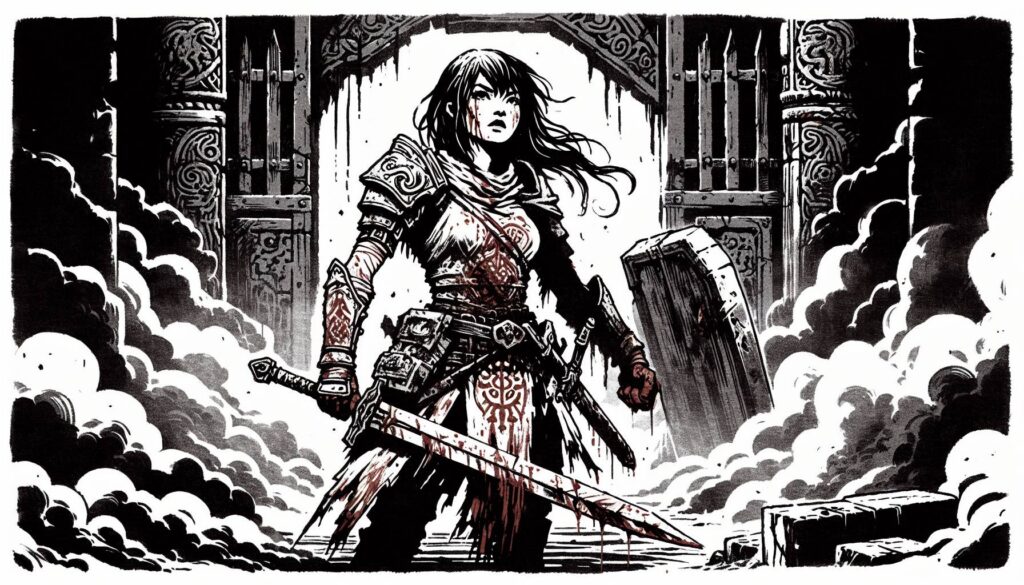
The Divide Among Artists
In the world of professional art, the advent of AI tools has generated a schism among artists. While some see these tools as invaluable allies in streamlining workflows and expanding creative possibilities, others view them as trespassers threatening centuries-old artistic traditions. The divide is characterized by contrasting perspectives on the benefits, harms, and potential compromises associated with AI in art creation.
For pro-AI artists, the appeal lies in efficiency and innovation. AI tools offer the ability to rapidly iterate on designs, automate mundane tasks, and explore creative ideas that were previously out of reach. This efficiency frees artists to focus on the more conceptual and expressive elements of their work, pushing the boundaries of what they can achieve.
However, anti-AI artists argue that the use of AI dehumanizes the art-making process. They fear it commodifies creativity, undermining the soul and intention that define human expression. The concern is not only for their livelihoods but also for the cultural erosion of artistic values as AI-generated art becomes more prevalent in the industry.
Straddling these camps are artists who adopt a middle-ground perspective, advocating for a conditional use of AI tools. They acknowledge the technology’s potential benefits but emphasize the importance of maintaining a human-centric approach. By leveraging AI as a supplement rather than a substitute for human creativity, these artists aim to harness the best of both worlds.
| Artist Perspective | Pro-AI (Benefits) | Anti-AI (Harms) | Middle-Ground (Conditional Use) |
|---|---|---|---|
| Efficiency and Innovation | Rapid iteration and automation | Loss of human touch and intention | AI used as a tool to enhance human creativity |
| Expanded Creative Freedom | Ability to explore new ideas | Commodification of artistic expression | Balancing AI efficiency with human artistry |
| Accessibility and Inclusivity | Lower barriers to entry | Threat to traditional artistic livelihoods | Setting clear boundaries for AI integration |
| Faster Production Times | Production cost reduction | Cultural erosion of artistic values | Encouraging collaboration between AI and artists |
| Enhanced Collaboration | Multi-disciplinary creative projects | Homogenization of artistic styles | AI augmenting, not replacing, human input |
| Exploration of New Mediums | New forms of artistic exploration | Misuse of AI leading to creative theft | Creativity-driven, not profit-driven AI use |
| Democratization of Art | Art creation accessible to non-traditional artists | Question of originality and authenticity | Hybrid creative processes for holistic output |
| Innovation in Education | New teaching tools and methodologies | Over-reliance on technology | Joint development of AI and human skills |
| Cross-Cultural Influences | Broader range of stylistic influences | Dilution of cultural-specific artistry | Respect for cultural narratives and diversity |
| Increased Engagement | Interactive and adaptive art experiences | Detachment between artist and audience | Maintaining emotional connection in art |
| Portfolio Diversification | Expanded artistic portfolios | AI replacing foundational skills | Ensuring art remains an expression of humanity |
| New Market Opportunities | Innovative revenue streams | Devaluation of traditional art markets | Responsible use of AI in creative commerce |
This table captures the diverse perspectives among artists, highlighting the complexity of the conversation surrounding AI in art. As the divide persists, it becomes clear that finding common ground and fostering dialogue is crucial to navigating the ethical landscape of creative technology.
Ultimately, the divide among artists underscores an important aspect of the AI debate—the need for nuance and empathy in understanding different viewpoints. Each perspective points towards a broader collective goal: ensuring that technology serves to elevate, rather than diminish, the art and artistry that lies at the heart of gaming. By embracing dialogue and collaboration, artists can better navigate AI’s integration while preserving the rich and diverse tapestry of human creativity.
⚔️ Fantasy RPG Random Tables Books
Make life as a Gamemaster easier…
If you play Dungeons & Dragons, Pathfinder, or other fantasy RPGs, this
RPG random tables series
is packed with encounters, NPCs, treasure, and more. Available in eBook or print—either way, you’ll have a wealth of adventure ideas at your fingertips.
Indie Games and the AI Temptation
For indie game studios, the decision to incorporate AI-generated art into their development processes presents unique challenges. Unlike larger developers with abundant resources, indie studios often operate under tight budget constraints and limited team sizes. This reality makes AI’s promise of cost savings and efficiency alluring but fraught with potential trade-offs. The choice between staying “authentic” and embracing AI-generated art is a pivotal one that can shape the identity and reception of an indie game.
One of the most pressing challenges indie devs face is budget limitations. Creating high-quality art is resource-intensive, and AI offers a cost-effective alternative. However, relying too heavily on AI-generated components risks losing the personal touch that many players cherish in indie games. The struggle to maintain visual consistency and artistic integrity while balancing financial realities is a constant juggling act.
Team size is another consideration for indie developers. Small teams often mean that individuals wear multiple hats, handling various aspects of game creation, from art and design to marketing and community engagement. AI tools can alleviate some of the workload, allowing team members to focus on critical tasks. Yet, the potential loss of creative control and the risk of alienating a dedicated fanbase loom large.
Community pressure also weighs heavily on indie developers. Many players are drawn to indie games for their authenticity and distinctiveness, often championing the handcrafted artistry that sets them apart from mainstream titles. Using AI-generated art can conflict with these values, prompting developers to weigh the risks of community backlash against the benefits of streamlined production.
- Budget limitations necessitating cost-effective art solutions.
- Small team sizes requiring task automation.
- The need for visual consistency across game assets.
- Risks of alienating a dedicated fanbase.
- Pressure to maintain artistic authenticity.
- Balancing creative control with production efficiency.
- Cultural identity and artistic voice preservation.
- Challenges in integrating AI tools with existing workflows.
- Addressing player expectations for originality.
- Risks of producing homogenized game visuals.
- Concerns over the devaluation of unique artistic styles.
- Navigating community reactions and feedback.
- Ethical considerations of AI’s impact on creative industries.
The challenges indie developers face in considering AI-generated art extend beyond technical considerations; they touch on the very ethos of what it means to create authentically and responsibly within the gaming industry. For many, these decisions are not just about efficiency—they’re about preserving a legacy of creativity and innovation that indie games have come to represent.
To close, indie developers occupy a unique position in the AI debate. Their choices may well influence the broader industry, offering insights into how creativity and technology can coexist harmoniously. By carefully navigating these challenges, indie studios have the opportunity to embrace AI in ways that augment their artistry while honoring the values that define their identity, ultimately shaping a future where innovation and tradition collide to create something truly extraordinary.
Community Clashes and Cultural Shifts
The introduction of AI-generated art has sent ripples through gaming communities, triggering debates that challenge core gamer identities and norms. As discussions intensify, these communities find themselves grappling with profound questions about authenticity, trust, and the evolving nature of art in the digital age. These cultural shifts reveal deeper tensions between technological advancement and the preservation of traditional values, with fans and creators engaging in passionate exchanges that reflect broader societal debates.
At the heart of these clashes is a reevaluation of what it means to be a creator, how we define art, and the extent to which technology should be allowed to redefine these concepts. For many, the fight against AI-generated art is not merely a resistance to change; it’s a defense of the emotional and cultural connections forged through human creativity. These conflicts often manifest in grassroots movements and organized campaigns aimed at raising awareness and influencing industry practices.
The debate over AI-generated art further underscores the complex relationship between gaming communities and developers. Trust, a foundational element of these relationships, is tested as players question whether their favorite studios’ commitment to artistic integrity remains intact. As these dynamics unfold, the gaming world stands at a crossroads, with the potential for significant cultural shifts that echo beyond the confines of the digital world.
Fan Reactions and Movements
In the face of AI’s burgeoning role in game art, fan communities have mobilized, organizing around both pro- and anti-AI sentiments. These movements are marked by a surge in grassroots activism, as fans leverage their collective voice to influence industry norms and advocate for the values they hold dear. The dynamic nature of these communities enables rapid organization, resulting in diverse actions that reflect a range of perspectives and priorities.
For fans opposing AI-generated art, the response has been fervent. Boycotts of games featuring AI elements, petitions demanding transparency in art sourcing, and campaigns promoting AI-free projects are just a few of the tactics employed to make their concerns heard. These movements often emphasize the importance of preserving the human touch in game artistry and safeguarding the cultural identity that resonates with players.
Conversely, some fan communities embrace the potential of AI, viewing it as an opportunity for creativity and innovation. They advocate for a nuanced understanding of AI as a tool that can complement human artistry rather than replace it entirely. These pro-AI movements focus on exploring how technology can be harnessed responsibly to enhance the gaming experience.
Social media plays a pivotal role in amplifying these fan-led actions, enabling the rapid dissemination of ideas and coordination of initiatives. Hashtags, online forums, and dedicated platforms provide spaces for discussion and organization, fostering a sense of solidarity and shared purpose among participants.
- Campaigns for transparency in art production processes.
- “No AI Art” pledges promoted by community leaders.
- Tagging and supporting AI-free projects on platforms like Kickstarter.
- Formation of art collectives dedicated to traditional artistry.
- Boycotting titles featuring AI-generated components.
- Social media campaigns advocating for human-created art.
- Petitions demanding stricter guidelines for AI usage in art.
- Collaborative fan art contests celebrating human creativity.
- Educational initiatives on the impact of AI in art.
- Community-driven crowdfunding efforts supporting traditional artists.
- Online discussions on ethical AI integration in creative industries.
- Partnerships between fan groups and artists to promote handmade art.
- Podcast series exploring the cultural implications of AI in gaming.
- Hashtag activism highlighting the uniqueness of human artistry.
- Volunteer-driven workshops on preserving art traditions.
- Interactive panels at conventions discussing AI and art.
These actions underscore the passionate commitment of fans to influence industry practices and uphold the values they cherish. As communities navigate the complexities of technology’s impact on art, their engagement is not just a display of advocacy—it’s a testament to the power of collective action in shaping the future of gaming.
The diverse fan reactions to AI-generated art reveal the multidimensional nature of this debate. These movements reflect a broader cultural shift, prompting gamers and creators alike to recalibrate their understanding of creativity, authorship, and authenticity. As the conversation continues, the role of fan communities in shaping industry practices and norms remains a pivotal force in navigating the cultural landscape of gaming.
Try my AI Tabletop RPG generators...and an extensive library of content!
Redefining “Art” in the Age of Algorithms
The encroachment of AI-generated art into the gaming space forces gaming communities and industry stakeholders to revisit fundamental questions about what constitutes art, creativity, and authorship. In an era where algorithms and human ingenuity intersect, the boundaries that have traditionally defined these concepts are being questioned and redefined, prompting a broader contemplation of artistic value.
In the traditional sense, art is an expression of human experience and emotion, imbued with intentionality and personal touch. It is often celebrated for its uniqueness, the reflection of an artist’s vision and expertise. AI-assisted and fully AI-generated art challenge this definition, necessitating a reevaluation of originality and authorship. If an algorithm creates an image that resonates emotionally or aesthetically, does it deserve the same recognition as human-crafted art?
This redefinition of art relates not just to production but also to perception. How audiences view and value art is changing as they grapple with the reality that machines can produce works that mimic or even rival human creation. The question arises: Does the essence of art lie in the process or in the product itself? The answer to this shapes not only industry standards but also cultural appreciation and acceptance of new forms of art.
The tension between these interpretations plays out in various forums and discussions, as communities debate and attempt to reconcile these evolving definitions with their own artistic values. The outcome of this discourse will have lasting implications for how art is created, curated, and celebrated in the context of gaming and beyond.
| Art Type | Authorship | Originality | Perception |
|---|---|---|---|
| Traditional Art | Singular vision of artist | Unique, handcrafted, intentional | Valued for emotional and cultural significance |
| AI-Assisted Art | Collaboration between human and machine | Blurred lines, influenced by algorithms | Mixed reception, seen as tool-augmented art |
| Fully AI-Generated Art | Machine-generated with minimal human input | Debate on creativity and novelty | Controversial, seen as lacking human essence |
This comparison highlights the evolving landscape of art creation, revealing the complexities and challenges inherent in redefining artistic norms. As traditional, AI-assisted, and fully AI-generated art coexist, gaming communities are at the forefront of exploring how these forms align—or conflict—with established values.
Ultimately, the redefinition of art in the age of algorithms is an ongoing conversation, one that invites both reflection and adaptation. It challenges us to appreciate the diverse forms of creativity that technology can enable while remaining mindful of the cultural and emotional connections that art fosters. As gaming communities continue to navigate these shifts, the dialogue initiated by these debates will shape the future of art and creativity, offering new insights and possibilities for artistic expression.
⚔️ Fantasy RPG Random Tables Books
Make life as a Gamemaster easier…
If you play Dungeons & Dragons, Pathfinder, or other fantasy RPGs, this
RPG random tables series
is packed with encounters, NPCs, treasure, and more. Available in eBook or print—either way, you’ll have a wealth of adventure ideas at your fingertips.
In conclusion, the integration of AI into art and its subsequent redefinition is not just a technological shift but a cultural one. It calls upon creators, audiences, and industries to engage in a collective exploration of what art can be and what it should represent in a world increasingly shaped by innovation. As these debates unfold, they promise to enrich our understanding of creativity and deepen our appreciation for the myriad ways art can enhance our lives.
Gatekeeping or Guardianship?
The resistance to AI in game art raises important questions about whether this pushback stems from a desire to preserve artistic integrity or from a more insidious form of gatekeeping, rooted in fear and elitism. As debates rage on, stakeholders must confront the underlying motivations driving these discussions and consider whether they are championing creatives or curtailing innovation.
For some, the resistance to AI is deeply rooted in a commitment to safeguarding the authenticity and emotional richness that human-made art represents. They argue that this pushback serves as a form of guardianship, protecting the cultural and artistic values that underpin creative expression. By setting boundaries and advocating for transparency and ethical guidelines, these advocates seek to ensure that art remains an authentic reflection of human experience and ingenuity.
Conversely, critics of this position suggest that the resistance to AI can veer into gatekeeping territory, where fear of change and a reluctance to embrace new technologies stifle innovation. They argue that clinging to traditional definitions of art may prevent the industry from exploring new creative horizons and discovering fresh ways to engage audiences. By dismissing AI’s potential outright, they caution that we may miss opportunities for collaboration and evolution.
The tension between gatekeeping and guardianship lies in the balance between preserving longstanding values and embracing progress. As the conversation continues, stakeholders must strive to discern between legitimate concerns and fears rooted in resistance to change, fostering a dialogue that respects the past while embracing the future.
In the end, the debate over gatekeeping versus guardianship serves as a prism through which to view the evolving landscape of art in gaming. By engaging in honest and open conversations about these motivations, the industry can navigate the complexities of integrating AI into art creation, ensuring a future that honors creativity and innovation in equal measure.
To close, the distinction between gatekeeping and guardianship is a nuanced one, but it holds significant implications for the artistic and cultural evolution of gaming. By embracing both caution and curiosity, stakeholders can explore the potential of AI while maintaining a steadfast commitment to the values that define art’s enduring impact. As this discourse unfolds, it invites us all to reflect on our own roles in shaping the future of creativity, not just in gaming, but in the wider world of art and expression.
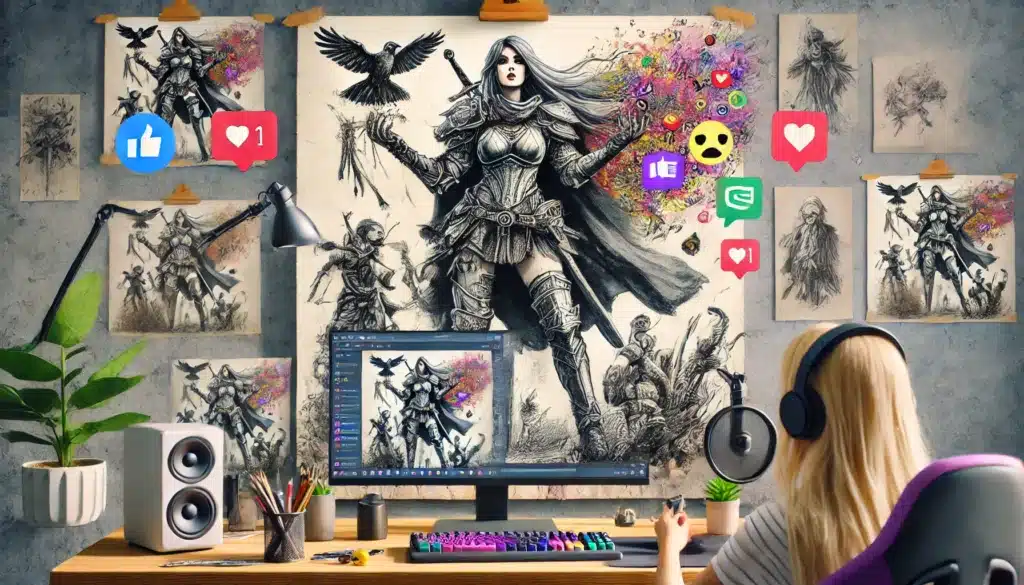
Looking Forward: AI’s Role in Gaming Art
As the gaming industry stands on the cusp of a new era marked by technological innovation, the role of AI in art creation promises to be both transformative and challenging. Navigating the future requires a careful balance between embracing new tools and preserving the core values that define artistic integrity and cultural expression. The path forward is not without its hurdles, but it is one brimming with opportunities for evolution, collaboration, and discovery.
The development of legal frameworks and regulatory measures will be pivotal in shaping the responsible use of AI in gaming art. Transparent guidelines, ethical standards, and disclosure tags can help bridge the gap between technology and artistry, ensuring that AI serves as an ally rather than a replacement for human creativity. Clear regulations will not only protect artists’ rights but also foster trust among stakeholders, aligning technological advancements with community values.
Hybrid workflows are likely to emerge as a promising middle ground, where AI augments the creative process without compromising the human touch. This collaborative approach could leverage AI’s strengths—such as rapid iteration and automation—while allowing artists to retain control over the creative direction. By fostering synergy between humans and machines, the industry can unlock new levels of artistic innovation, enhancing the gaming experience for players and creators alike.
Despite these advancements, it is crucial to anticipate potential pushbacks and challenges that may arise as AI’s role in art evolves. Maintaining open communication and dialogue between creators, fans, and industry leaders will be essential to addressing concerns, dispelling misconceptions, and fostering a shared vision for the future of gaming art.
AI as a Collaborative Tool
The prospect of AI as a collaborative tool in game art creation represents a middle ground, where technology enhances rather than replaces human artistry. This partnership can unlock a wealth of creative possibilities, enabling artists to explore fresh ideas and push the boundaries of their craft. By integrating AI responsibly, the industry can preserve the essence of human creativity while embracing the efficiency and innovation that technology offers.
AI’s potential as a creative collaborator is vast, encompassing tasks that range from mundane automation to complex idea generation. For instance, AI can assist in generating intricate backgrounds and landscapes, enabling artists to focus on the central elements of their compositions. By providing visual references and idea sketches, AI can serve as a springboard for artistic exploration, inspiring creators to venture into new creative territories.
Moreover, AI can facilitate the iterative design process, offering rapid prototyping and experimentation without the resource constraints typically associated with traditional methods. This efficiency empowers artists to test new concepts, refine their work, and ultimately deliver more polished and engaging visuals. Collaborative workflows that leverage AI’s strengths can enhance the artistic vision while maintaining the authenticity and emotional resonance that players cherish.
- Automating repetitive tasks in art creation.
- Generating intricate background landscapes.
- Offering visual references for concept development.
- Providing idea sketches to inspire new creations.
- Rapid prototyping for quick iteration cycles.
- Assisting in color palette exploration and adjustments.
- Streamlining texture mapping and detail enhancement.
- Creating placeholder assets for early-stage development.
- Facilitating real-time feedback and design adjustments.
- Enhancing character design with adaptive algorithms.
- Generating environmental effects and atmospheric elements.
- Assisting with lighting simulations and dynamic shadows.
- Improving visual consistency across game assets.
- Offering style transfer for artistic experimentation.
- Creating modular design components for easy customization.
- Facilitating cross-platform art adaptation.
- Streamlining asset management and organization.
- Supporting collaborative workflows among dispersed teams.
By embracing AI as a collaborator, the industry can cultivate a creative environment where technology amplifies artistic expression. This harmonious integration can unlock new levels of creativity, ensuring that gaming art continues to captivate and inspire audiences across the globe.
Leveraging AI as a collaborative tool offers the potential to redefine the landscape of game art creation. By fostering an environment where technology and creativity coexist, the industry can chart a path that honors the artistic spirit while embracing the innovations that shape our digital future. As we navigate this evolving landscape, the promise of AI as a creative ally offers a glimpse into the exciting possibilities that lie ahead.
Regulating AI in Game Production
The integration of AI into game production presents a unique set of challenges and opportunities that require thoughtful regulation to ensure ethical and responsible use. As the industry moves forward, establishing clear guidelines and standards will be crucial in addressing the complexities introduced by AI, safeguarding the interests of artists, developers, and players alike.
Transparent regulations are paramount to ensuring that AI technology aligns with the core principles of artistic integrity and cultural sensitivity. Implementing disclosure tags and AI-free certifications can help differentiate between human-crafted and AI-augmented content, fostering transparency and trust among consumers. These measures will empower players to make informed choices about the games they engage with, reflecting their values and preferences.
The enforcement of these regulations will require collaboration between industry stakeholders, governmental bodies, and cultural institutions. By working together, they can establish a framework that addresses the diverse needs of the gaming community while promoting innovation and creativity. Potential effects of these regulations include increased accountability for publishers, enhanced clarity for consumers, and a vibrant ecosystem that supports both technological advancement and artistic expression.
| Proposed Regulation | Enforcement Body | Potential Effects |
|---|---|---|
| Transparency in AI Use | Industry self-regulation, governmental oversight | Increased consumer trust and awareness |
| Disclosure Tags for Content | Industry standards organizations | Clear differentiation between AI and human-created content |
| AI-Free Certifications | Independent certification bodies | Promotion of traditional artistry and consumer choice |
| Licensing for AI Art Tools | Government agencies, industry consortia | Ensures ethical use and distribution of AI technology |
| Copyright Protections | National and international legal frameworks | Protects artists’ rights and intellectual property |
| Ethical Standards for AI | Joint industry and academic initiatives | Promotes responsible development and deployment of AI tools |
| Support for Hybrid Workflows | Industry collaborations, educational programs | Fosters collaboration between AI and human creativity |
| AI Usage Audits | Third-party auditing firms | Ensures compliance with regulations and ethical guidelines |
| Cross-Platform Standards | International gaming coalitions | Facilitates compatibility and consistency across platforms |
| Consumer Feedback Mechanisms | Industry feedback channels | Provides insights into consumer preferences and areas for improvement |
The path to regulating AI in game production is complex, but it is a necessary endeavor to safeguard the future of gaming art. By fostering a collaborative approach that emphasizes transparency, accountability, and innovation, the industry can navigate the challenges and opportunities presented by AI with confidence and integrity.
⚔️ Fantasy RPG Random Tables Books
Make life as a Gamemaster easier…
If you play Dungeons & Dragons, Pathfinder, or other fantasy RPGs, this
RPG random tables series
is packed with encounters, NPCs, treasure, and more. Available in eBook or print—either way, you’ll have a wealth of adventure ideas at your fingertips.
In conclusion, the regulation of AI in game production is an essential step in ensuring that technology enhances rather than diminishes the creative landscape. By establishing clear guidelines and fostering collaboration among stakeholders, the industry can promote ethical and responsible use of AI, preserving the artistic values that define gaming while embracing the innovations that propel it forward. As we look to the future, these regulations will play a pivotal role in shaping a vibrant and dynamic ecosystem that celebrates creativity in all its forms.
The Cultural Legacy of the Debate
The debate over AI-generated art has left an indelible mark on the cultural landscape of gaming, shaping not only the games we play but also our understanding of creativity, authorship, and artistic value. As the conversation continues, the cultural legacy of this debate will be defined by the ways in which it challenges us to reexamine our relationship with technology and the role it plays in shaping creative expression.
The integration of AI into art creation prompts a reevaluation of the values and principles that underpin our appreciation of art. It forces us to confront questions about what it means to be a creator, the nature of originality, and the authenticity of artistic expression. These discussions have the potential to deepen our understanding of creativity, encouraging a more nuanced appreciation for the diverse forms of art that technology can enable.
Moreover, the debate underscores the importance of preserving cultural identity and heritage in the face of technological change. As AI-generated art becomes more prevalent, it is essential to ensure that cultural narratives and artistic traditions remain at the forefront of gaming experiences. The preservation of these values will serve as a testament to the enduring power of art to connect, inspire, and unite people across cultures and generations.
Ultimately, the cultural legacy of this debate will be shaped by the ways in which we navigate the complexities of integrating technology into art. By fostering open dialogue and embracing the challenges and opportunities presented by AI, we can chart a course that honors the rich tapestry of human creativity while embracing the innovations that define our digital age. As we look to the future, the cultural impact of this debate will continue to resonate, shaping the way we perceive and value art in the years to come.
In closing, the cultural legacy of the AI art debate offers a powerful reminder of the dynamic interplay between tradition and innovation. By engaging thoughtfully with the challenges and opportunities presented by this evolving landscape, we can ensure that creativity remains a vibrant and transformative force in gaming and beyond. As we continue this journey, the lessons we learn and the values we uphold will define the future of art and creativity in an increasingly interconnected world.
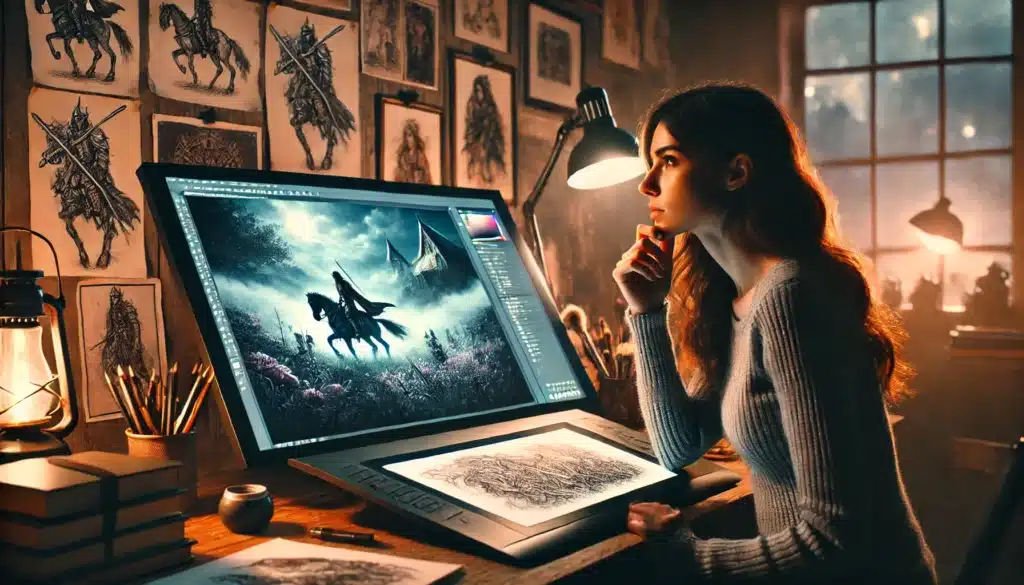
Final Thoughts on Art, AI, and Community Integrity
The discourse surrounding AI-generated art in gaming is a multifaceted conversation that encompasses not only technological advancements but also the core values that define creativity and community. As we reflect on the complexity of this debate, it becomes clear that the questions it raises go beyond tools and techniques—they touch on the fundamental aspects of artistic expression, cultural identity, and the collaborative spirit that fuels innovation.
At the heart of the conversation lies the need for transparency and respect for artists. As technology continues to evolve, it is crucial to ensure that artists retain control over their work and receive recognition for their contributions. Open dialogue between creators, fans, and industry stakeholders can foster an environment where AI is embraced as a creative ally rather than a replacement, allowing for new forms of artistic expression to flourish.
Moreover, the debate highlights the importance of community integrity and the role that collective action plays in shaping industry practices. Fans and creators alike have the power to influence the direction of gaming art, advocating for policies and practices that align with their values and priorities. By engaging in meaningful discussions and collaborating to address the challenges posed by AI, communities can help to preserve the cultural significance of art in the gaming experience.
The AI art debate also invites us to reflect on the kind of artistic future we want to build. It challenges us to consider how we can harness technology to enhance creativity while remaining true to the values that define artistic expression. By embracing both innovation and tradition, we can create a future where art continues to inspire, connect, and elevate the human experience.
In conclusion, the debate over AI-generated art in gaming is an ongoing journey that requires thoughtful consideration and collaboration. By prioritizing transparency, respecting artists, and fostering open dialogue, we can navigate the complexities of this evolving landscape with integrity and vision. As we move forward, the choices we make and the values we uphold will shape not only the future of gaming art but also the broader cultural legacy of creativity in our digital age.
Try my AI Tabletop RPG generators...and an extensive library of content!


